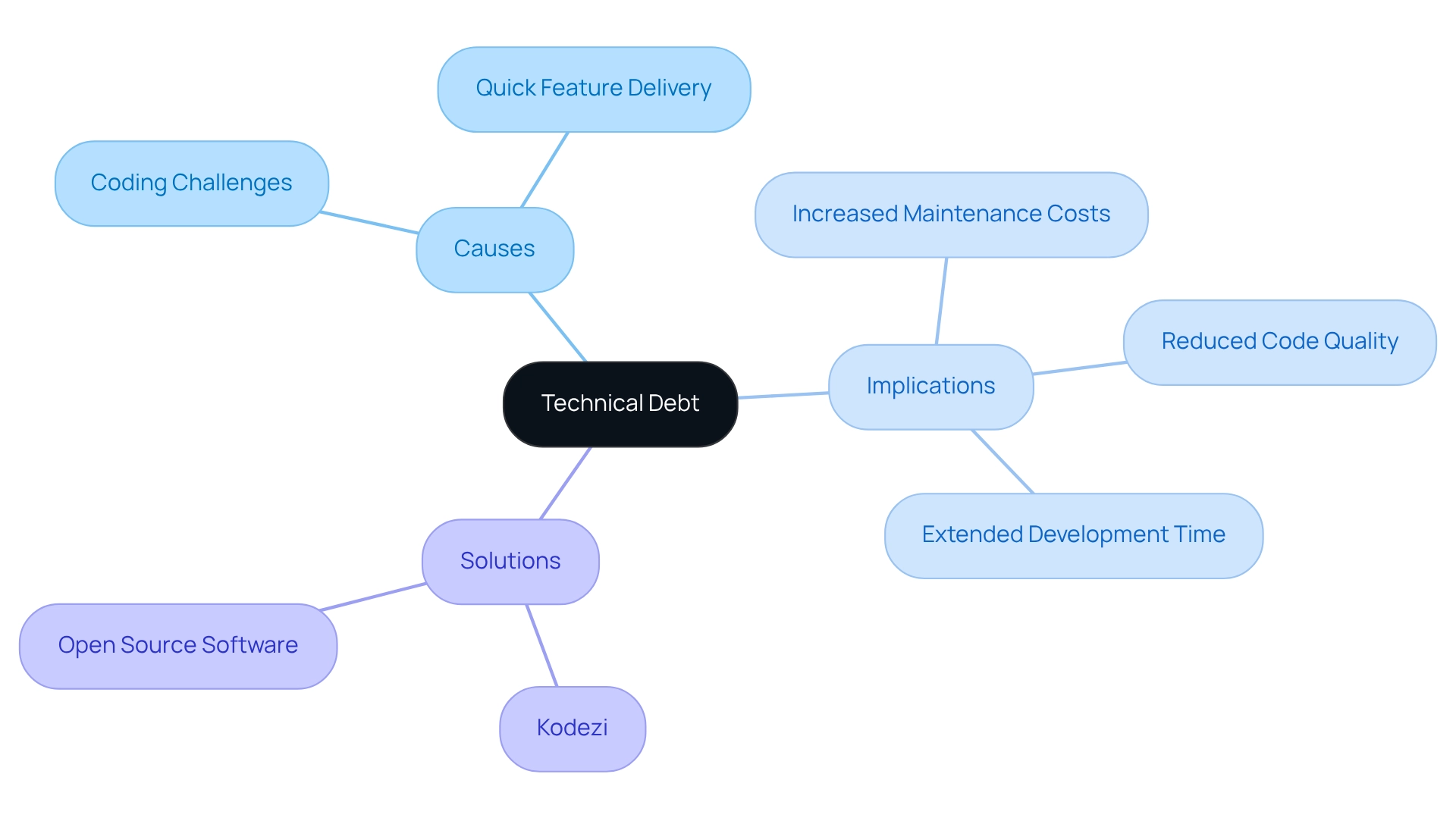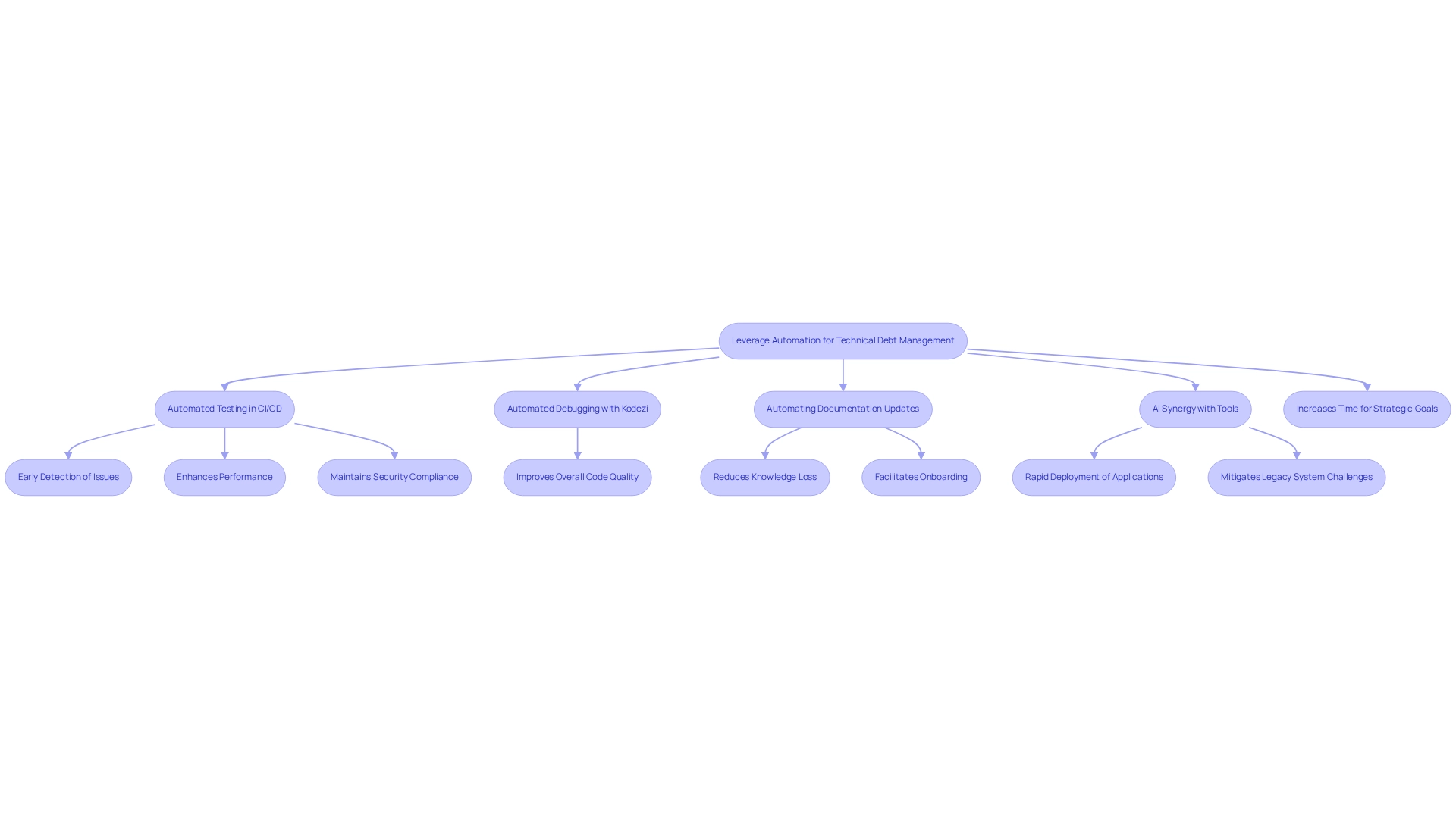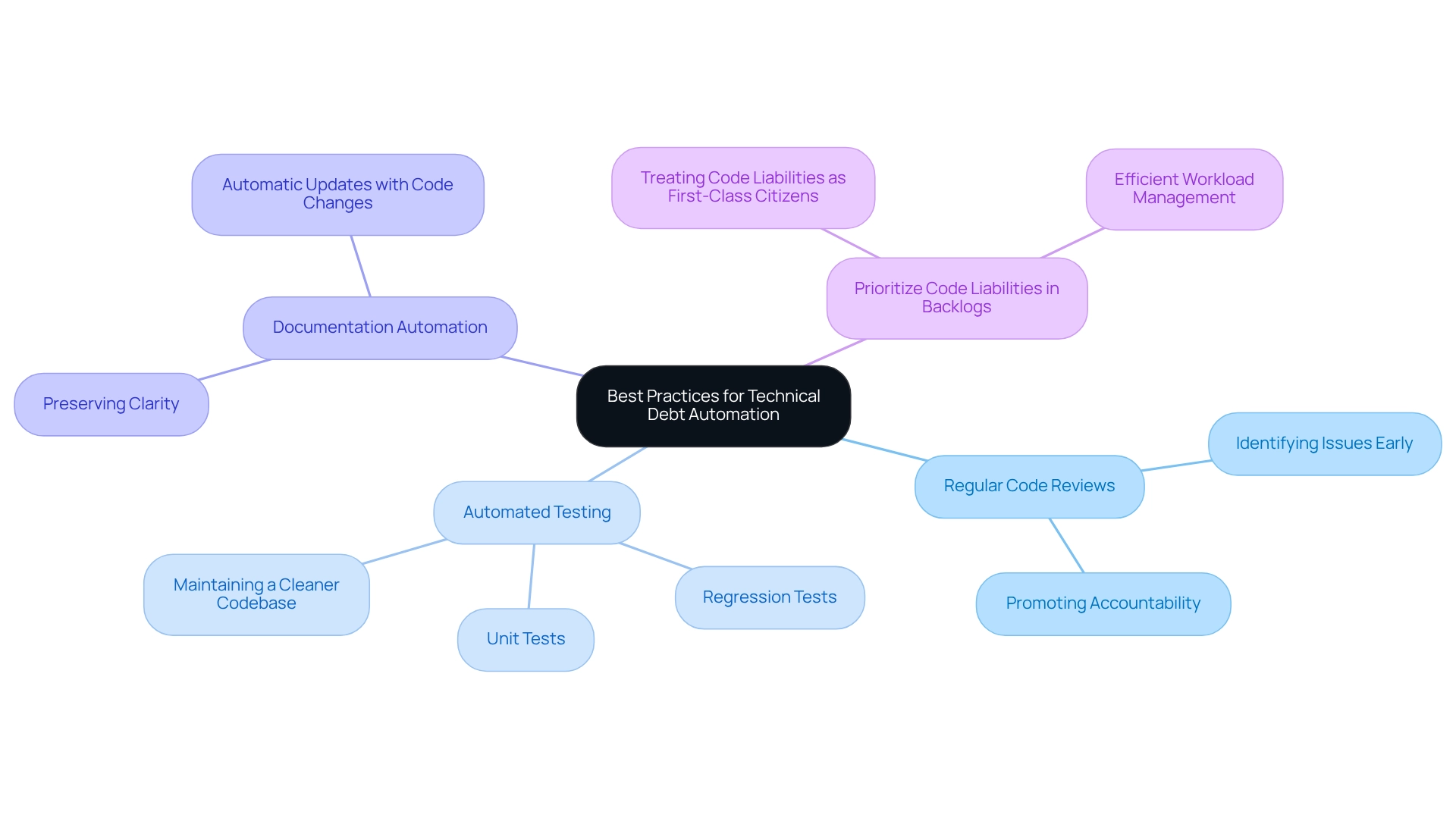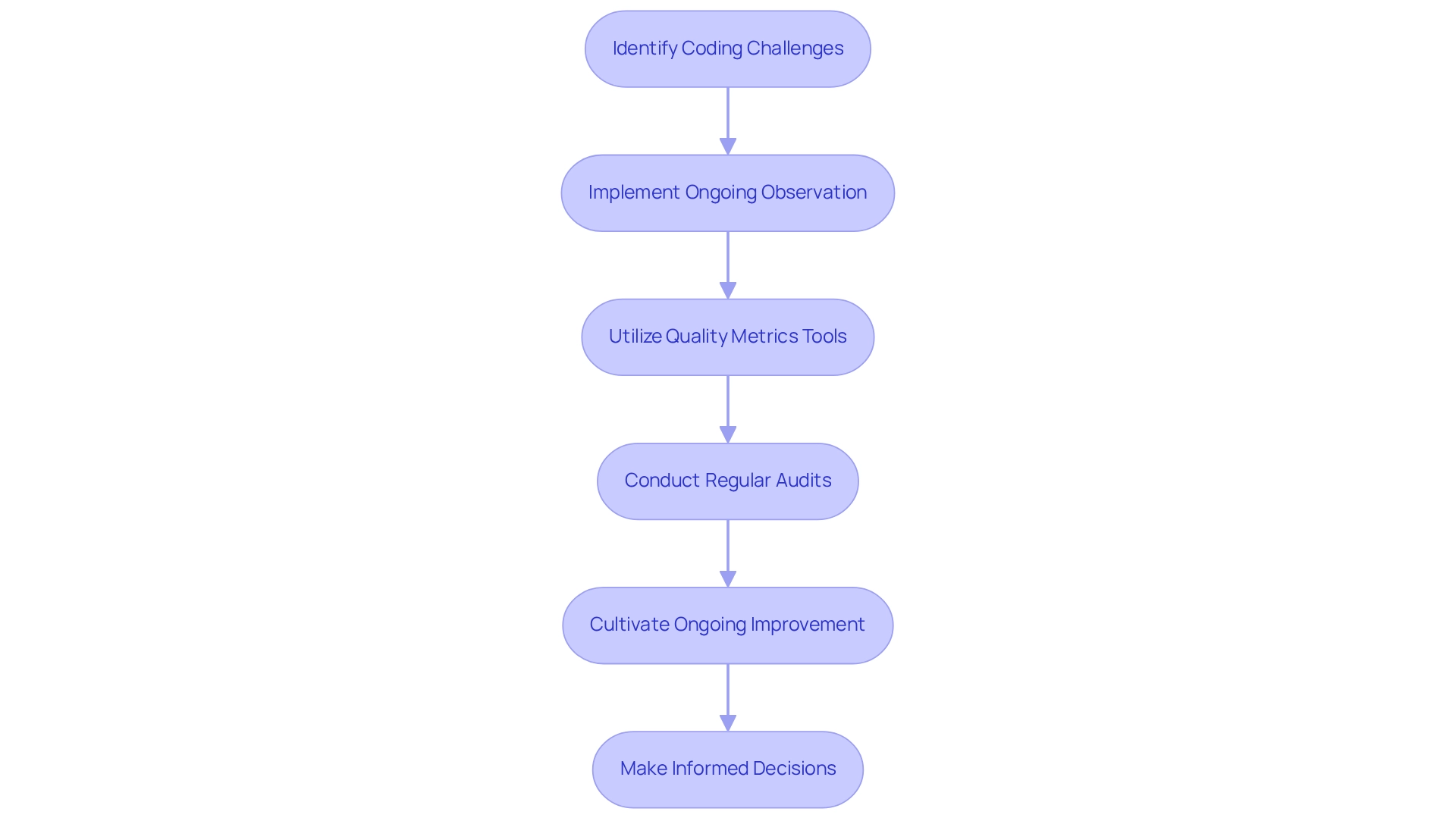Overview
Coding challenges are a common hurdle that developers encounter, particularly when it comes to managing technical debt. This is where Kodezi comes into play, offering automation tools designed to address these issues effectively. By integrating Kodezi into your workflow, you can streamline processes and enhance productivity.
The strategies for effective technical debt automation are crucial for improving code quality. Best practices such as:
- Regular code reviews
- Automated testing
- Documentation automation
are essential in this regard. These practices not only mitigate risks associated with technical debt but also foster an environment of continuous improvement.
Furthermore, the benefits of using Kodezi are significant. By leveraging its features, developers can expect to see improved productivity and a noticeable enhancement in code quality. This ultimately leads to a more efficient development process, allowing teams to focus on innovation rather than remediation.
Are you ready to explore the tools available on the Kodezi platform? Discover how these solutions can transform your coding practices and help you effectively manage technical debt.
Introduction
In the fast-evolving landscape of software development, coding challenges are a common hurdle that developers face. As engineering teams strive for efficiency and innovation, the concept of technical debt has emerged as a critical concern. Defined as the implied cost of future rework stemming from quick, less effective solutions, technical debt manifests in various forms, such as legacy code and inadequate documentation. Furthermore, as organizations prioritize rapid feature delivery, they often inadvertently accumulate this debt, leading to increased maintenance costs and prolonged development cycles.
In 2025, understanding the severity of technical debt is more crucial than ever. It influences strategic decision-making and the overall health of codebases. How can teams effectively manage this challenge? By leveraging automation tools and best practices, such as those offered by Kodezi, teams can proactively address technical debt. Kodezi provides features that streamline coding processes, enhance documentation, and optimize legacy code management.
The benefits of using Kodezi are significant: improved productivity, higher code quality, and reduced maintenance overhead. By utilizing these tools, teams can ensure they remain competitive in an increasingly complex technological environment. Explore the tools available on the Kodezi platform and discover how they can transform your coding practices.
Define Technical Debt and Its Implications
Coding challenges are a common hurdle for developers, often resulting in the need for technical debt automation that can have lasting impacts. Technical debt automation signifies the implied cost of future rework, which arises from choosing simpler solutions over more effective methods that require additional time. This can manifest in various forms, such as legacy programming, inadequate documentation, and outdated libraries. The consequences are significant, often resulting in increased maintenance expenses, reduced code quality, and extended development periods.
Have you ever noticed how teams might prioritize quick feature delivery? This can unintentionally lead to the accumulation of technical debt automation, complicating future improvements and increasing the likelihood of bugs. In 2025, it's crucial to recognize that technological liabilities can be classified by their severity, with anything above 0.7 considered critical, as highlighted by industry leaders. This classification aids in prioritizing remediation efforts.
Furthermore, the integration of open-source software (OSS) into development processes is essential for fostering innovation while effectively managing technological burdens. Kodezi, an AI-driven programming solution, exemplifies how to tackle these challenges. It automatically examines and fixes scripts, enabling teams to address issues proactively. Specifically, Kodezi CLI serves as a versatile tool for B2B engineering teams, independently enhancing software quality and resolving issues before they reach production.
In addition, Kodezi stands out by emphasizing autocorrecting code rather than merely autocompleting it, providing a unique advantage in managing complexities. Real-world examples illustrate how organizations utilizing reusable components from experts can significantly reduce their technological burdens. By doing so, developers can concentrate on their core strengths, ultimately improving overall agility and innovation potential, while understanding and classifying technical debt automation is vital for implementing effective management and reduction strategies. Explore the tools available on the Kodezi platform to enhance your coding practices and experience the benefits of improved productivity and code quality.

Leverage Automation to Manage Technical Debt
In the fast-paced world of software development, coding challenges can often impede progress. To efficiently manage technological liabilities, engineering groups should leverage technical debt automation resources like Kodezi, which consistently tracks software quality and identifies potential liability buildup. Integrating automated testing within CI/CD pipelines is vital, as it allows for early detection of issues, thereby supporting technical debt automation and preventing the accumulation of new technical debt. For instance, Kodezi's automated debugging feature helps teams swiftly identify and resolve codebase issues, enhancing performance and maintaining security compliance. This functionality provides comprehensive explanations and insights into what occurred and how it was addressed, enabling teams to proactively tackle problems before they escalate, ultimately improving overall code quality.
Furthermore, automating documentation updates is essential for maintaining a clear and comprehensible codebase, significantly reducing the risk of knowledge loss over time. By ensuring that README files, changelogs, and inline documentation are consistently updated, teams can enhance maintainability and facilitate smoother onboarding for new engineers.
Statistics indicate that companies actively managing their technological obligations can empower engineers to allocate up to 50% more time to strategic business objectives, highlighting the substantial impact of automation on productivity. Moreover, the synergy of AI with tools such as Kubernetes facilitates rapid deployment and oversight of containerized applications, mitigating challenges associated with outdated systems. By utilizing these automated solutions, including Kodezi CLI's self-sufficient features that enhance code quality and resolve issues before production, teams can significantly alleviate the burden of technological obligations through technical debt automation, positioning themselves for greater competitiveness in the evolving tech landscape. Ultimately, automation acts as a self-maintaining mechanic shop for self-driving cars in software development.

Implement Best Practices for Technical Debt Automation
To effectively implement technical debt automation in management, teams should embrace the following best practices:
- Regular Code Reviews: Establishing a routine for peer evaluations is essential for identifying potential issues early. Frequent evaluations not only improve code quality but also promote a culture of accountability, alleviating the weight of unmet commitments that can cause irritation among groups.
- Automated Testing: Incorporating unit tests and regression tests is crucial to guarantee that new modifications do not create further issues. By identifying issues early, groups can maintain a cleaner codebase and reduce risks related to technical debt.
- Documentation Automation: Utilizing tools that automatically update documentation in tandem with code changes ensures that documentation remains aligned with the current state of the codebase. This practice is essential for preserving clarity and minimizing confusion, particularly in larger groups.
- Prioritize Code Liabilities in Backlogs: Treating code liabilities as a first-class citizen in your backlog is essential. Setting aside specific time for its resolution while developing features aids groups in managing their workload efficiently and avoids the buildup of obligations over time.
By adopting technical debt automation methods, groups can foster a sustainable strategy for handling technological obligations, ultimately improving their development procedures and product quality. For example, a case study on the effect of time limitations showed that understanding how these pressures lead to complications can assist teams in prioritizing essential tasks and discovering creative solutions. As Rafael Timbó, Chief Technology Officer, observes, grasping technological liabilities and handling them becomes considerably simpler when developers are adept at resolving problems as they occur. In 2025, the focus on assessing and enhancing metrics related to technology will be crucial for reducing risks and improving decision-making in software development. Additionally, addressing Service/Versioning Debt is crucial, as inadequate versioning can lead to significant challenges in maintaining legacy systems.

Establish Continuous Monitoring and Improvement Strategies
Developers often face significant coding challenges that can hinder their productivity. Implementing ongoing observation methods is essential for efficiently handling technological liabilities. Utilizing tools that monitor quality metrics—such as complexity, test coverage, and debt-related issues—allows teams to maintain a clear perspective on their codebase health. Regular audits and assessments are crucial for identifying potential concerns before they escalate into significant problems. Furthermore, cultivating an environment of ongoing enhancement motivates individuals to actively tackle issues during their development phases.
How can Kodezi help address these challenges? By using dashboards to display metrics related to issues, teams can make informed decisions about prioritizing refactoring initiatives. Tools like Kodezi can automate debugging, quickly recognizing and addressing codebase issues while providing detailed explanations of what occurred and how it was corrected. This emphasizes the importance of visualizing metrics to improve software quality and aligns with the industry's drive for high availability and minimal downtime. For instance, in fields like telecommunications, achieving 'five nines' (99.999%) availability is a typical objective.
By incorporating these practices into the development process, teams can ensure that challenges are managed efficiently and sustainably. This ultimately leads to higher quality software solutions and enhanced innovation. Ongoing monitoring approaches, combined with suitable tools such as Kodezi, significantly reduce the risks associated with technical debt automation, enabling engineering teams to focus on delivering value rather than merely maintaining code. In addition, trialing different tools is advisable to find the best fit for a team's needs, ensuring that the strategies implemented are both effective and tailored to specific challenges. Explore the tools available on the Kodezi platform to enhance your coding practices today.

Conclusion
Technical debt poses a significant challenge for software developers, impacting both productivity and code quality. This issue can manifest in various forms, including legacy code and insufficient documentation, leading to higher maintenance costs and extended development cycles. As we approach 2025, effectively categorizing and managing technical debt will be crucial for organizations aiming for rapid feature delivery without compromising code integrity.
So, how can engineering teams tackle this challenge? Leveraging automation tools like Kodezi equips them with the capabilities to proactively address technical debt. By incorporating features that automate code debugging and documentation updates, teams can streamline their workflows, minimize debt accumulation, and ultimately reclaim valuable time for strategic initiatives. Furthermore, the benefits of automation extend beyond efficiency; it cultivates a culture of accountability and continuous improvement, which is essential for maintaining high-quality software development.
To combat technical debt effectively, implementing best practices such as regular code reviews, automated testing, and prioritizing technical debt in backlogs empowers teams to face challenges directly. These strategies not only mitigate the risks associated with technical debt but also foster a sustainable development environment where innovation can thrive. As the software development landscape evolves, prioritizing the effective management of technical debt through automation and best practices will be vital for maintaining a competitive edge and delivering exceptional value to users.
Frequently Asked Questions
What is technical debt automation?
Technical debt automation refers to the implied cost of future rework that arises from opting for simpler solutions instead of more effective methods that require additional time. It can manifest in forms such as legacy programming, inadequate documentation, and outdated libraries.
What are the consequences of technical debt automation?
The consequences include increased maintenance expenses, reduced code quality, and extended development periods. It can also complicate future improvements and increase the likelihood of bugs.
How can teams unintentionally accumulate technical debt?
Teams may prioritize quick feature delivery, which can lead to the accumulation of technical debt automation, complicating future improvements and increasing the likelihood of bugs.
How is technological liability classified?
Technological liabilities can be classified by severity, with anything above 0.7 considered critical. This classification helps in prioritizing remediation efforts.
What role does open-source software (OSS) play in managing technological burdens?
The integration of OSS into development processes is essential for fostering innovation while effectively managing technological burdens.
How does Kodezi help in addressing technical debt automation?
Kodezi is an AI-driven programming solution that automatically examines and fixes scripts, allowing teams to proactively address issues. Kodezi CLI enhances software quality and resolves issues before they reach production.
What is the unique advantage of Kodezi compared to other tools?
Kodezi emphasizes autocorrecting code rather than merely autocompleting it, providing a unique advantage in managing coding complexities.
How can using reusable components from experts benefit organizations?
Utilizing reusable components can significantly reduce technological burdens, allowing developers to focus on their core strengths, which enhances overall agility and innovation potential.
Why is understanding and classifying technical debt automation important?
Understanding and classifying technical debt automation is vital for implementing effective management and reduction strategies to improve coding practices and productivity.




